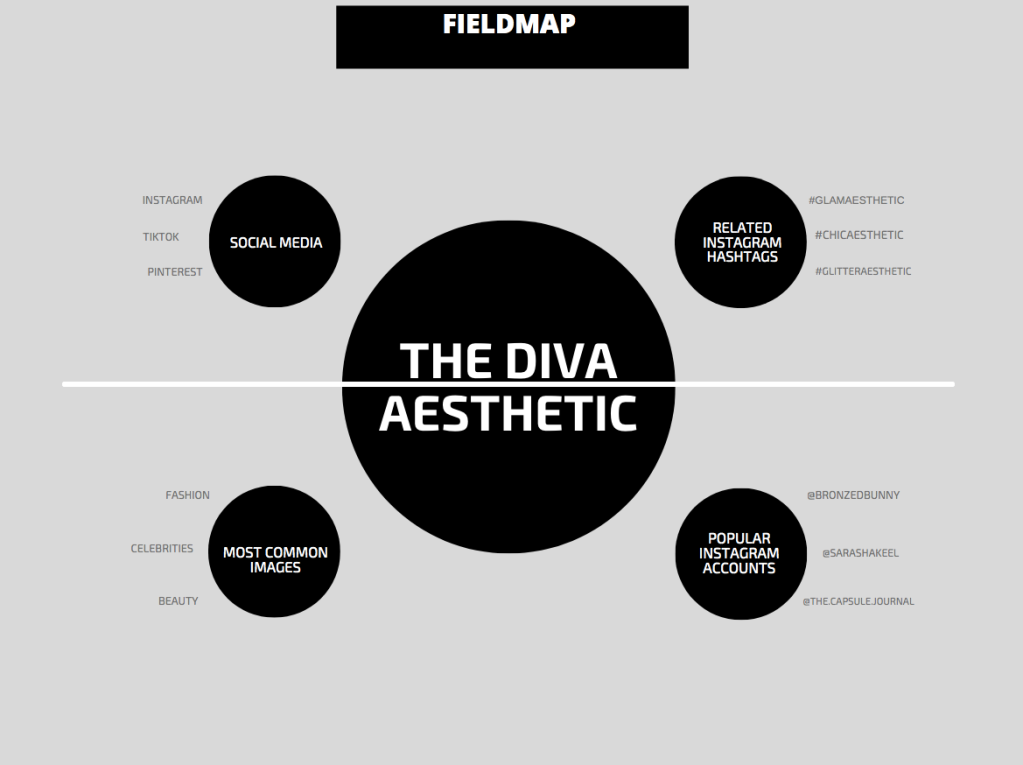https://anchor.fm/samantha222/embed/episodes/241-1-e15t83t/a-a6bghil
My Digital Artefact is officially up and running. This week, I created an Instagram page and have ethnographically begun exploring the opulent aesthetic. “The term aesthetics is used broadly to encompass the perception, production, and response to art, as well as interactions with objects and scenes that evoke an intense feeling, often of pleasure,” (Brielmann & Pelli, 2018).
It is extremely important to identify and define the field site. In ethnography the term field site refers to “the spatial characteristics of a field-based research project, the stage on which the social processes under study take place” (Burrell, 2009). It is important to identify and define the field site early on within the chosen field of study. The field site importantly acts as a guide allowing the researcher to identify where they should be located as a participant observer. Below is the mapping for the field site of the glam aesthetic. The map shows a clear focus on the glam aesthetic hashtag.

There are many social media platforms that feature the glam aesthetic, in particular TikTok, Pinterest and Instagram. There is a great deal of outreach on all these social media networks, and it would be extremely difficult to focus the research across all of them. I chose to focus on Instagram to narrow the field, a platform I spend most of my time on, liking pictures and following accounts that stand out to me and connect with friends. This style of social media is basic in the sense that it revolves around uploading an image or video. However, Instagram is also a saturated field and after a lot of brain-storming, will further be focusing on the hashtag glamaesthetic. By providing a deeper focus on this particular hashtag, I will be creating my own aesthetic named the diva aesthetic.
Instagram hashtags relating to the diva aesthetic include;
#glamaesthetic 6.2k posts
#chicaesthetic 1.4k posts
#glitteraesthetic 26.3k posts
Instagram pages that embody the diva aesthetic include;
@bronzedbunny 21.4k followers and 426 posts
@sarashakeel 1mil followers and 3084 posts
@the.capsule.journal 10.6k followers and 402 posts
There is a large following of this particular aesthetic, making it difficult to pin down a specific persona exemplified in the images. Images are specifically reflective of the account’s personal preference. Preferences include, the subject matter of the image, the filter/effects used and tone. This embodies the diva aesthetic and allows users to share their own creative preferences, which is something I will consider when crafting my own digital artefact. “We live in a digital electronic world, based on images designed to capture eyeballs and build brand names, create mindshare and design successful products and services,” (Aljukhadar, Bériault Poirier & Senecal, 2020). This research will be beneficial to understand the effects aesthetics can have on consumers while shopping.
As I am part of this particular niche, the research will be reflexive. Reflexive research is important in the ethnography field as the main goal of the research is to describe a culture or subculture (Field-Springer).
I will be able to take field notes on my own personal experience with the aesthetic. Being a part of the culture will help myself gain better insight into this topic.
References
Aljukhadar, M., Bériault Poirier, A. and Senecal, S. (2020), “Imagery makes social media captivating! Aesthetic value in a consumer-as-value-maximizer framework”, Journal of Research in Interactive Marketing, Vol. 14 No. 3, pp. 285-303, viewed 12th August 2021, <https://doi-org.ezproxy.uow.edu.au/10.1108/JRIM-10-2018-0136>
Brielmann, AA & Pelli, DG 2018, ‘Aesthetics’, Current biology, vol. 28, no. 16, pp. R859–R863, viewed 13th August 2021.
Burrell, J 2009, ‘The Field Site as a Network: A Strategy for Locating Ethnographic Research’, Field Methods, vol. 21, no. 2, pp. 181–199, viewed 11th August 2021, <https://search-ebscohost-com.ezproxy.uow.edu.au/login.aspx?direct=true&db=a9h&AN=41589347>.
Field-Springer, K n.d., ‘Reflexive embodied ethnography with applied sensibilities: methodological reflections on involved qualitative research’, Qualitative Research, vol. 20, no. 2, pp. 194–212, viewed 10 August 2021, <https://search-ebscohost-com.ezproxy.uow.edu.au/login.aspx?direct=true&db=edselc&AN=edselc.2-52.0-85064532564>.
advice aesthetic analysis archaeology audience autoethnography BCM215 BCM241 BCM325 blog climate change comparing cultural capital Digital Artefact discussion emotions engaging environment ethnographic skill ethnography fashion feedback films future game media games innovative marketing media nostalgic peer peers persona pins Pinterest reflect retro students tiktok tweets Twitter undead visuals youth zombies